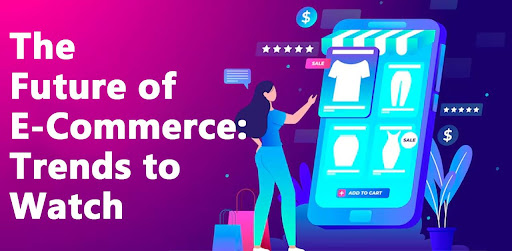E-commerce has transformed how we shop and do business, growing rapidly in recent years. According to Viral vamp online shopping has become a staple in daily life because it's so convenient and tech-savvy. To stay ahead and meet customer expectations as this digital world evolves, businesses need to keep up with the latest trends. By staying informed and adapting to these changes, companies can seize new opportunities, improve customer experiences, and set themselves up for success in the ever-changing e-commerce landscape.
1. Mobile Commerce (M-Commerce)
The preferred method of shopping for consumers is quickly evolving into mobile commerce, or M-commerce. As consumers rely more and more on smartphones for shopping, companies need to give priority to developing mobile-friendly websites and apps. The ease of browsing and making purchases while on the go is what is causing this shift, so businesses must make sure their online platforms are mobile-friendly. According to Viral Vamp, M-commerce is growing in today's digital environment due in part to the expansion of mobile payment options and digital wallets like Apple Pay and Google Wallet, which have made transactions faster and more secure.
<iframe width="560" height="315" src="https://www.youtube.com/embed/ReLBU0yqzI0?si=BMjrg--MBimMFEsO" title="YouTube video player" frameborder="0" allow="accelerometer; autoplay; clipboard-write; encrypted-media; gyroscope; picture-in-picture; web-share" referrerpolicy="strict-origin-when-cross-origin" allowfullscreen></iframe>
2. Personalization and AI Integration
E-commerce is starting to rely heavily on personalization, and artificial intelligence is helping to make the process even better. Through customer data analysis, artificial intelligence (AI) can provide customized product recommendations, increasing the relevance and fun factor of shopping for users.
Furthermore, chatbots and virtual assistants driven by AI offer effective customer support, promptly and precisely resolving problems. Businesses can develop more successful marketing strategies by using these technologies to better understand consumer preferences. AI-driven personalization not only boosts customer satisfaction but also increases sales and brand loyalty, making it a key trend to watch in the future of e-commerce.
3. Social Commerce:
The popularity of shopping on social media platforms is driving a rapid growth in social commerce. Through apps like Instagram, Facebook, and others, where products are easily incorporated into their feeds, consumers are increasingly making direct purchases. Influencers are crucial to these sales because their endorsements and recommendations frequently result in hasty purchasing decisions. Additionally, the incorporation of in-app purchasing features allows users to shop without ever leaving their favorite social media platforms, enhancing user convenience and engagement. The way businesses engage and communicate with their customers online is being altered by this movement.
4. Sustainability and Ethical Shopping
As more people look for products that fit with their values, sustainability and ethical shopping are rising to the top of the consumer priority list. As a result, companies are emphasizing sustainable practices and products more and more. Supply chains that are transparent are essential because they let consumers know where and how products are made, which guarantees ethical sourcing and manufacturing. The importance of eco-friendly packaging is growing as it lessens waste and its impact on the environment. Businesses that implement these strategies not only satisfy consumer demand but also improve their brand recognition and customer loyalty by contributing to a more sustainable future.
5. Subscription Based Models:
Models that rely on subscriptions have grown in popularity because they give customers convenience and customized experiences. From beauty products to meal kits, subscription services deliver curated items regularly, making shopping easier and more enjoyable. For businesses, this model provides a steady revenue stream, helps build customer loyalty, and allows for better inventory management. Consumers benefit from the convenience of automatic deliveries and the excitement of discovering new products. Companies like Dollar Shave Club, Blue Apron, and Birchbox have successfully leveraged this model, demonstrating its potential to create long-term relationships with customers while ensuring consistent business growth.
6. Cross-Border E-commerce
Cross-border e-commerce is growing quickly and provides companies with new revenue streams and access to international markets. The management of logistics, customs laws, and inconsistent delivery schedules are some of the difficulties associated with international shipping, though. To succeed, businesses must also focus on localized content and payment options to cater to diverse customer preferences. Providing website translations, currency choices, and local payment methods can enhance the shopping experience and boost conversions. Businesses can turn international markets into profitable opportunities by adopting these strategies to help them get past obstacles and capitalize on the growing demand for global online shopping.
7. Voice Commerce
As smart speakers like Google Home and Amazon Echo become more commonplace in homes, voice commerce is growing quickly. Voice commands are becoming more and more popular among consumers for product searches, shopping, and payment. Businesses can optimize their content for voice search by concentrating on long-tail and natural language keywords and making sure their content is formatted to respond to frequently asked voice queries. Adding voice-activated features can improve customer satisfaction and increase revenue. With new opportunities for convenience and engagement, voice-based e-commerce is expected to grow in the future. Companies that catch on to this trend early will be in a good position to take the lead in this changing industry.
Closing Remark:
Asviral Vamp concluded, the e-commerce industry is changing due to dynamic trends like social shopping, AI integration, and mobile commerce. To remain ahead of the curve, one must embrace these shifts and implement sustainable practices, mobile optimization, and AI for individualized experiences. Businesses need to adjust to new opportunities and challenges as voice and cross-border e-commerce grow in popularity. Companies may improve customer experiences, spur growth, and maintain their competitiveness in the dynamic digital marketplace by following these trends and never stopping to innovate. To succeed in the future of e-commerce, one must remain knowledgeable and adaptable.




.png)

Comments